Art Therapy in Response to Natural Disasters, Mass Violence and Crisis is a new Jessica Kingsely publication edited by Joseph Scarce.
I am honoured to be one of the authors in this wonderful new book.
…
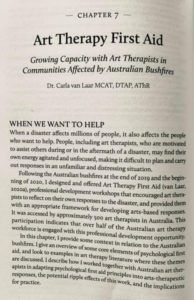
…
Editor Joseph Scarce has done a great job bringing this material together and was very kind and helpful to work with. Thank you Joseph.
…
“With contributions from a range of expert voices within the field, this book explores the use of art therapy as a response to traumatic events. Offering rare insight into ways in which art therapists have responded to recent crises, this is a unique resource for art therapists looking to coordinate interventions for large-scale disaster and resulting trauma.
Chapters address a range of environmental and manmade disasters around the world, including hurricanes, typhoons, wildfires, mass shootings and forced migration, highlighting the impact of an art therapy approach in dealing with widespread trauma.
Covering both community and individual cases, it provides an in-depth view into the challenges of working in these settings, including the effects on the therapist themselves, and offers practical information on how to coordinate, fund and maintain responses in these environments.
The first book to focus on disaster response in art therapy, this will be an invaluable contribution to the field in an increasingly vital area.”
– From the Amazon review page where the book can be purchased:
…
My chapter focuses on the Art Therapy First Aid approach developed in support of Creative Arts Therapists responding to the impact of Australian bush fires in their own communities.
I write:
“When a disaster affects millions of people, it also affects the people who want to help. People, including art therapists, who are motivated to assist others during or in the aftermath of a disaster, may find their own energy agitated and unfocussed, making it difficult to plan and carry out responses in an unfamiliar and distressing situation.
Following the Australian bushfires at the end of 2019 and the beginning of 2020, I designed and offered Art Therapy First Aid (van Laar, 2020a) professional development workshops that encouraged arts therapists to reflect on their own responses to the disaster, and provided them with an appropriate framework for developing arts-based responses. It was accessed by approximately 500 art therapists in Australia.
This participation indicates that over half of the Australian art therapy workforce engaged with this professional development opportunity.”
…
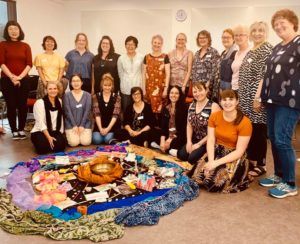
Participants at the 2020 Art Therapy First Aid workshop at Western Sydney University.
…
In the chapter, I describe how:
“The fire season of 2019–2020 did not fully end until May 2020. The air quality in Australian capital cities was the worst in the world for weeks. Our air was full of smoke, and we had to stay indoors. Across Australia, 35 people died.
Over 3,500 homes were lost. 46,300,000 acres of land was burned. This is an area that is equivalent to the size of Syria or four times the size of Denmark. The smoke from these fires travelled across the ocean, polluting the air of New Zealand as well as Chile and Argentina.
The fires have become known as the worst wildlife disaster of modern history. Nearly 3 billion animals were killed, injured or displaced.
Eighty percent of Australians were impacted by the fires in some way, including multiple losses: homes, pets, wildlife, human lives, livelihoods, and grief, like the grief I felt for a place that I deeply love (Centre for Disaster Philanthropy, 2019).”
…

…
I introduce the Psychological First Aid approach:
“This hopeful and optimistic perspective “involves helping people feel safe, connected to others, calm and hopeful, and ensuring access to physical, emotional and social support.
Psychological first aid aims to reduce initial distress, meet current needs, promote flexible coping and encourage adjustment” (APS, 2020, p. 15).
Psychological First Aid aims to build people’s capacity to recover, and we are reminded that “one of the most important research findings is that a person’s belief in their ability to cope can predict their outcome” (APS, 2020, p. 17).”
…

From the first Art Therapy First Aid fund raising work shop in January 2020.
…
Art Therapy processes are readily adaptable and accessible ways to embody the core principles of Psychological First Aid. As I write in the chapter:
“I gave an overview of the core elements of Psychological First Aid, and invited participants to divide into five groups, one for each core elements: safety, calm, connection, efficacy, and hope.
They were asked to work together to create an art-based activity through which participants could experience one of the elements.
They had plenty of space available to work in, as well as lots of art materials, including traditional paint, paper, drawing and collage materials, clay, as well as textiles, found objects, and recycled bits and pieces.
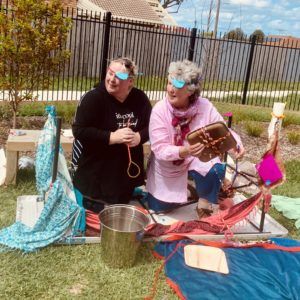
Creative Arts Therapists playing together to experience self-efficacy at the Geelong workshop, February 2020.
Each group designed their activities and set them up for the other participants to engage with. The atmosphere was festive and playful. The activities ranged from improvised weaving to hand massages, making clay containers for messages of hope, a sensory walk and an up-turned table that became a boat to play in.
Designing and participating in the activities was a fun, joyous, and inspiring process.”

Creative Arts Therapists offering hand massages amidst art materials at the Melbourne workshop, January 2020.
…
Synchronously, the day my copy of the book arrived, I packed up my van to head back to Croajingalong National Park for the first time since the fires.
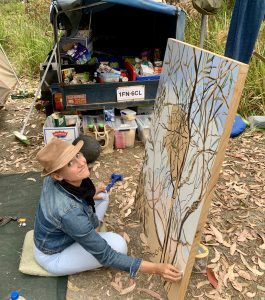




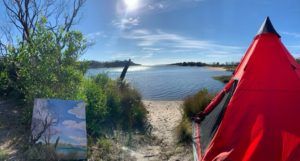
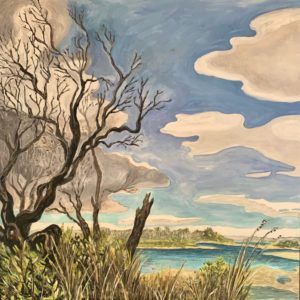
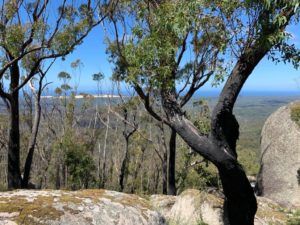
As I wrote at the end of the chapter:
“It is my sincere wish that the ripple effects of the Art Therapy First Aid approach will continue to expand, and be adapted by others working in their own communities to support safety, calm, connection, efficacy, hope, and the natural human capacity for healing—even in the face of devastating disaster.”
…
The Art Therapy First Aid Experiential Video Workshop is free to view online here. It includes an overview of the Psychological First Aid approach and has a number of creative processes for you to engage in. Expect to pause the video multiple times while you do the creative work.
…
My artworks are made in loving memory of the billions of animals who lost their lives in the 2019/20 bushfires.
My thoughts are with all the communities who have been affected by fires, I honour your capacity for connection and hope.
…

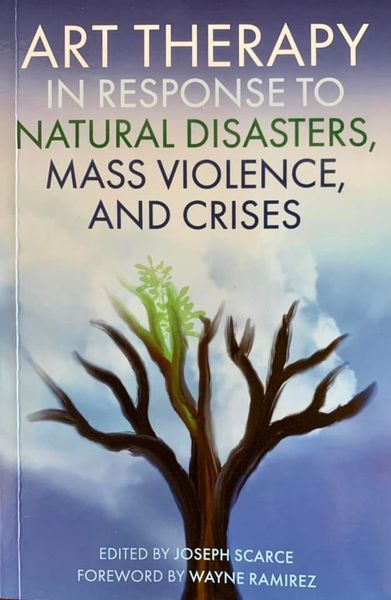
One Comment
Kim
Into the lions den … such an awe inspiring review of your therapeutic work, your stunning art and your heart for this work, Carla . Thankyou